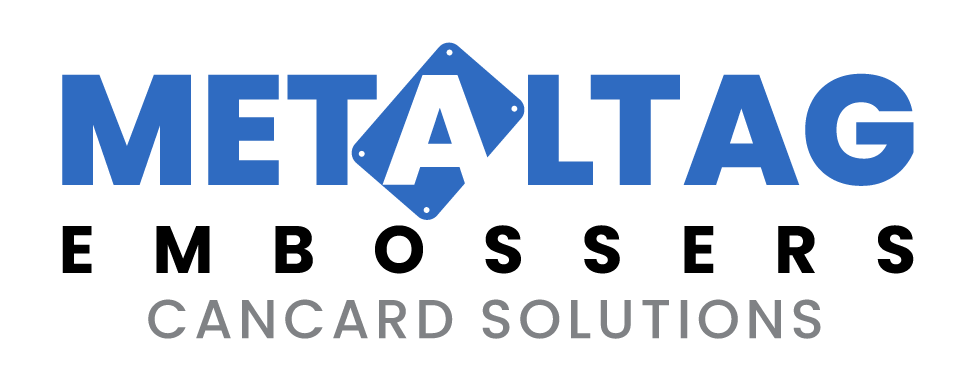When it comes to identification and marking, industries can’t rely on labels or printed tags that fade over time. They need durable, professional, and compliance-ready solutions. That’s where embossing machines come in.
In this article, we’ll explain what an embossing machine is, how it works, types of embossers, and why they are critical in industrial applications such as oil & gas, defense, manufacturing, and healthcare.
What is an Embossing Machine?
An embossing machine is a device that creates raised (embossed) or indented (debossed) characters, numbers, and symbols on materials such as metal plates, plastic cards, or composite tags.
Unlike printing, embossing doesn’t use ink. Instead, it presses a die onto the surface to create a permanent, readable mark. This makes embossed tags resistant to corrosion, abrasion, chemicals, and extreme environments.
In industries where compliance and durability matter, embossing is the gold standard.
How Does an Embossing Machine Work?
The basic working principle of embossing is straightforward:
- A blank metal or plastic tag is fed into the machine.
- A die or stylus applies force to the tag’s surface.
- Characters, numbers, or barcodes are pressed into (debossed) or raised from (embossed) the surface.
- The final tag is permanent, clear, and tamper-resistant.
Advanced embossers also integrate automation, barcode systems, or database connectivity for bulk production.
Types of Embossing Machines
Not all embossers are the same. The right machine depends on your scale, budget, and compliance needs.
1. Manual Embossing Machines
- Cost-effective, compact, and ideal for low-volume tagging.
- Often used in small workshops or by companies needing occasional tags.
2. Automatic Embossing Machines
- Designed for high-volume industrial production.
- Features like motorized feed, programmable settings, and integration with databases.
- Saves time, labor, and ensures consistent quality.
3. Metal Tag Embossing Machines
- Specifically engineered for industrial environments.
- Produces corrosion-resistant plates for oil rigs, pipelines, utilities, and defense.
4. Embossing vs Engraving Machines
- Embossing: Raises or indents characters, fast and durable for bulk tagging.
- Engraving: Cuts into the surface, ideal for high-detail customization.
- For compliance + speed → embossing is preferred.
Benefits of Using an Embossing Machine
Organizations across industries choose embossing because of these advantages:
- Unmatched Durability – Resistant to extreme heat, chemicals, water, and abrasion.
- Compliance-Ready – Supports OSHA, ISO, and MIL-STD tagging standards.
- Professional Appearance – Crisp, clear, and easy-to-read tags.
- Scalable Production – Automatic machines produce thousands of tags efficiently.
- Cost Savings – Reduces outsourcing and increases in-house control.
Industrial Applications of Embossing Machines
Embossing is not limited to one sector — it’s a backbone of industrial identification.
- Oil & Gas / Marine – Embossed stainless-steel plates withstand saltwater, corrosion, and extreme environments.
- Manufacturing & Utilities – Asset tags, equipment labels, and compliance plates.
- Military & Defense – Metal dog tags, weapon identification, and rugged compliance plates.
- Healthcare & Logistics – Durable tags for medical equipment, patient ID systems, and supply chain compliance.
Example: A marine equipment manufacturer adopted an automatic metal tag embosser to create corrosion-proof tags, cutting replacement costs by 40%.
Choosing the Right Embossing Machine
Selecting the best embossing machine depends on:
- Volume → Small needs = manual; bulk production = automatic.
- Environment → Harsh conditions = stainless steel metal tag embosser.
- Compliance Needs → If OSHA/MIL standards apply, embossing is mandatory.
Cancard offers a full range of Metal Tag Embossing Machines — from manual embossers to automatic high-volume systems.
FAQs about Embossing Machines
Q1. What is the difference between embossing and engraving?
Embossing raises or indents the surface; engraving cuts into it. Embossing is faster and more durable for bulk industrial tags.
Q2. Can embossing be done on stainless steel?
Yes, stainless steel tags are common in oil & gas, marine, and defense industries.
Q3. How long do embossed tags last?
With proper material, embossed tags can last decades, even in extreme environments.
Q4. Do embossing machines require high maintenance?
No, most industrial embossers are low-maintenance, requiring only regular cleaning.
Q5. Which industries use embossing machines?
Oil & gas, marine, defense, manufacturing, healthcare, and logistics.
Conclusion
So, what is an embossing machine? It’s not just a marking tool — it’s a critical investment in safety, compliance, and durability. From small workshops to global industries, embossing ensures your identification remains professional and permanent.Ready to get started? Explore Cancard’s Metal Tag Embossers and request a free quote today.

